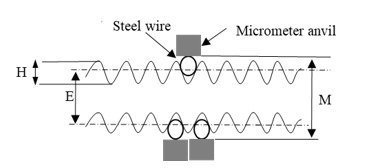
Virtual Labs
IIT Kharagpur

Measurement of Screw Threads Parameters using Two-Wire or Three-Wire Methods

Virtual Labs
IIT Kharagpur

Measurement of Screw Threads Parameters using Two-Wire or Three-Wire Methods
Screw threads are commonly used in mechanical assemblies to provide secure connections and transmit force. Accurate measurement of their key parameters, including major diameter, is crucial for ensuring proper functioning and transmission of load.
Two-wire method:
The two-wire method utilizes two wires of equal diameter placed tangentially on opposite flanks of the screw thread. The distance between the wires is measured using a micrometer. The wire diameter, pitch of the thread, and the effective diameter (E) can be calculated. Figure 1 below represents the two-wire technique.

Fig. 1 Two wire technique
Three-wire Method:
The three-wire method is a more accurate technique than the two-wire method for the measurement of screw thread parameters. This method involves placing three wires of known diameter in contact with the screw thread flanks, forming an equilateral triangle. Figure 2 below represents the three-wire technique.

Fig. 2 Three-wire technique
Calculation:
Metric thread is used in this experiment having thread angle ( α ) = 60 °
(i) Two-wire method:

Fig. 3 Two-wire measurement
M = distance over the wire, measured using a suitable micrometer.
Effective diameter ( E ) = T + P
Where T is the dimension under the wire till the point of contact between wire and screw flank, and P is the correction factor
And, T = M - 2d
d = diameter of the wire
P = p/2 cot ( α/2 ) – d [ cosec ( α/2 ) - 1 ]
p = pitch of the thread
α = thread angle = 60 ° ( for metric thread )
E = T + P
T = M – 2d
P = p/2 cot ( α/2 ) – d [ cosec ( α/2 ) - 1 ]
(ii) Three-wire method:

Fig. 4 Three-wire measurement
M = distance over the wire, measured using a suitable micrometer.
p = pitch of the thread screw
Height of threads ( H ) = p/2 cot ( α/2 )
α = angle of thread = 60 ° ( for metric thread )
E = M – d [ 1 + cosec ( α/2 ) ] + p/2 cot ( α/2 )